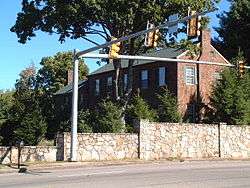Statesview
Statesview, or States View, is a historic house located on South Peters Road off Kingston Pike in Knoxville, Tennessee, United States. Built in 1805 by early Knoxville architect Thomas Hope and rebuilt in 1823 following a fire, Statesview was originally the home of surveyor Charles McClung (1761–1835). Following McClung's death, newspaper publisher Frederick Heiskell (1786–1882) purchased the house and estate, which he renamed "Fruit Hill."[3] The house is listed on the National Register of Historic Places for its architecture and political significance.[1]
Statesview | |
 Statesview's surroundings are much changed since 1806 | |
| Location | About 10 mi. SW of (Downtown) Knoxville off U.S. 70 |
|---|---|
| Nearest city | Knoxville, Tennessee |
| Coordinates | 35°54′13″N 84°4′31″W |
| Architectural style | Federal[1] |
| NRHP reference No. | 73001805[2] |
| Added to NRHP | April 24, 1973[2] |
Design
Statesview is a simple, two-story Federal-style brick house,[1] located on a wooded lot opposite the intersection of South Peters Road and George Williams Road. The house consists of a main section, a smaller (but still two stories) northeast wing, and a modern rear addition.[1] The main section consists of a central entry hall flanked by rooms on either side, with a staircase leading to the second story.[1] It is unknown how closely the current house, reconstructed following a fire in 1823, resembles the original house, or if it includes any part of the original.[1]

History
Statesview was built for early Knoxville surveyor Charles McClung, a son-in-law of Knoxville founder James White.[4] McClung drew up the original 1791 plat of Knoxville, and surveyed what is now Kingston Pike during the same period.[4] Construction on Statesview, then located in an isolated area west of Knoxville, began around 1804, and was completed in 1805.[1] To build the house, McClung hired Thomas Hope, an English-born architect and house joiner who had previously built the Ramsey House in east Knox County.[5]
Following McClung's death in 1835, his heirs sold the house and estate to Frederick Heiskell.[6] Heiskell had cofounded the Knoxville Register, the city's leading newspaper, in 1816.[6] Prior to purchasing Statesview, however, he sold his interest in the paper and retired.[7] Heiskell renamed the estate "Fruit Hill."[3]
By the time Heiskell purchased Statesview, the estate consisted of 1,200 acres (490 ha),[7] and included a gristmill along nearby Sinking Creek (modern Ten Mile Creek) known as "Mansion Mill" (replaced circa 1870 by the current Ebenezer Mill),[8] as well as a sawmill.[7] Heiskell planted extensive orchards throughout the estate, where he grew apples, pears, peaches, cherries, plums, and quinces. He also raised horses, cattle, and hogs.[7]
Around 1880, Heiskell, then in his early 90s, moved back to Knoxville.[9] The ownership of Statesview passed to his stepson, James Fulkerson.[6]
See also
References
- Ellen Beasley, National Register of Historic Places Nomination Form for Statesview, 2 November 1972.
- "National Register Information System". National Register of Historic Places. National Park Service. April 15, 2008.
- Nannie Lee Hicks, Mary Rothrock (ed.), "Some Early Communities," The French Broad-Holston Country: A History of Knox County, Tennessee (Knoxville, Tenn.: East Tennessee Historical Society, 1972), p. 334.
- Mary Rothrock, The French Broad-Holston Country: A History of Knox County, Tennessee (Knoxville, Tenn.: East Tennessee Historical Society, 1972), pp. 446-7.
- Mary Rothrock, The French Broad-Holston Country: A History of Knox County, Tennessee (Knoxville, Tenn.: East Tennessee Historical Society, 1972), pp. 428-429.
- Mary Rothrock, The French Broad-Holston Country: A History of Knox County, Tennessee (Knoxville, Tenn.:East Tennessee Historical Society, 1972), p. 423.
- A Forty-Niner from Tennessee: The Diary of Hugh Brown (Knoxville, Tenn.: University of Tennessee Press, 1998), p. xiv.
- Ann Bennett, Historic and Architectural Resources of Knoxville and Knox County, Tennessee, May 1994, p. 32. Retrieved: 18 April 2011.
- Samuel G. Heiskell, Andrew Jackson and Early Tennessee History (Nashville: Ambrose Printing Company, 1918), p. 80.
- Knoxville: Fifty Landmarks. (Knoxville: The Knoxville Heritage Committee of the Junior League of Knoxville, 1976), page 10.